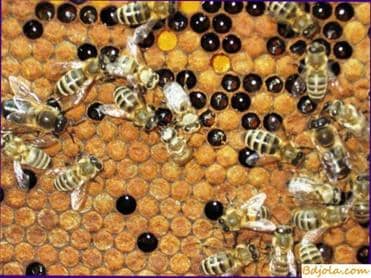
One summer morning, just as if a dozing hive at the bees of scouts suddenly comes to a strong excitement. Sobbing in the tap, the bees begin to fly out of the nest, as if some unknown force drives them. Insects, trying to get ahead of each other, hurry and hard take off and, as in a whirlwind, a black stream swirl over the apiary. They then go up and down, then back away. Standing above the apiary is the exhilarating call-roaring ringing, to which more and more bees come out of the hive along with the uterus. With the first swarm the old uterus flies out.
Not for long, 4-5 minutes, this celebration lasts. Then a small group of bees gather on some branch. To it others join. And soon a huge mass of insects, clinging to each other, hangs in a bunch and stops. This is the new young family – the swarm. Swarming is the birth of a family, the most significant event in the life of honey bees.
The size of swarms are different. The most numerous swarm weighs about 5 kg. In such a swarm there can be up to 50 thousand insects.
Quietly and calmly, as if hiding, sits a swarm. A 15-20 minutes, sometimes an hour on some yet to unravel the signal-scout bees in a moment falls apart, removed from the place, making a farewell circle above his native house and flies away to a new home. More often to the forest or a lonely tree standing, forever forgetting about its nest and all the treasures left in it. Why does not the swarm immediately fly to a new place of residence?
It is believed that bees must gather, make sure of the presence of the uterus, without which the family can not exist, once again to thoroughly examine the area of its future housing and already with confidence to move.
It is not necessary to try to plant swarm bees. They themselves will stop and will be privatized not far from their parents’ house. This landing at the intermediate station from the nest to the new housing is natural and for the swarm necessary. The main thing is to remove the swarm in time.
Where does the swarm know where is his new apartment? A few days before the swarming, the bee-scouts are looking for a hollow or an empty hive on some other apiary. They carefully examine it, pinpoint the location, size and report to the bees that are about to fly with the swarm. With this new home other bees are acquainted and for a day or two before digging they even set up a guard there, so that other bees do not settle in it. Therefore, the swarm immediately flies to where he planned to live.
However, not always, especially in treeless places, the swarm in advance finds to itself suitable habitation. But he still flies away from the apiary, somewhere sits down to rest, again sends out intelligence bees and so on until he settles on permanent residence.
And if there is a free beehive in the native apiary, will the swarm dwell in it? It turns out, no. If the new families settled right there, next to their parents’ house, and did not fly away, then soon there would come a time when the terrain was overpopulated by bees and forage was not enough for everyone. The famine would begin.
In the desire to swarm away far from their native places, the great wisdom of nature is hidden – to preserve the appearance of honey bees.
Пчелы темные. Как вести себя с пчелами.
Young Beekeeper